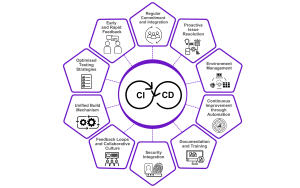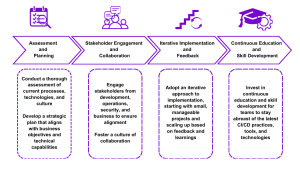Dive into the depths of Continuous Integration/Continuous Delivery (CI/CD) with us in this comprehensive blog post. We’ll explore the significance of CI/CD in modern software development, share best practices, and unveil effective implementation strategies tailored for today’s dynamic teams. Whether you’re a seasoned developer or just stepping into the world of CI/CD, this guide is your roadmap to streamlining your development process and achieving greater efficiency and reliability in your projects.
CI/CD integrates continuous integration, delivery, and deployment into the software development lifecycle, fostering agility, efficiency, and product quality. Continuous Integration (CI) automates merging code changes, facilitating early detection of integration errors. Continuous Delivery (CD) automates code delivery to various environments, and Continuous Deployment automates the release, allowing changes to be deployed to production automatically.

Unified Build Mechanism: Use the same build across all environments to maintain consistency and reduce integration errors.
Optimised Testing Strategies: Implement a mix of unit, integration, and end-to-end tests to cover all aspects of the application while maintaining a balance between coverage and speed.
Early and Rapid Feedback: Implement mechanisms for immediate feedback on code quality, security vulnerabilities, and integration issues to enable quick fixes.
Regular Commitment and Integration: Encourage developers to commit changes frequently and integrate them into the main branch to minimise merge conflicts and identify issues early.
Proactive Issue Resolution: Develop a culture of immediate action on failing builds or identified issues to maintain the integrity of the codebase.
Environment Management: Use infrastructure as code (IaC) to efficiently manage pre-production and production environments, ensuring consistency and reproducibility.
Continuous Improvement through Automation: Evaluate and improve your CI/CD pipeline for automation opportunities, including using AI and machine learning for predictive analytics and automated decision-making.
Documentation and Training: Maintain comprehensive documentation of the CI/CD process and provide regular training sessions for the team to understand and effectively use the pipeline.
Security Integration: Incorporate security practices early in the development process through DevSecOps, ensuring that security considerations are integral to the CI/CD pipeline.
Feedback Loops and Collaborative Culture: Foster a culture of continuous feedback and collaboration among cross-functional teams to improve the development process and product quality.
Canary Releases and Feature Flags: Implement canary releases and feature flags to gradually introduce new features to subsets of users, enabling safer deployments and rollback capabilities.
Performance and Scalability Testing: Regularly perform load testing and scalability assessments to ensure the application can handle expected traffic and data volumes.
Simplification and Consolidation: Evaluate the toolchain regularly to eliminate redundancies and consolidate tools where possible, simplifying the pipeline and reducing maintenance overhead.
Software Composition Analysis: Use software composition analysis tools to manage open-source dependencies, ensuring compliance and addressing security vulnerabilities.
Beyond traditional metrics, consider incorporating advanced analytics and machine learning to predict potential bottlenecks and optimise the pipeline. Metrics such as deployment frequency, change lead time, mean time to recovery, and change failure rate provide insights into the efficiency and reliability of the CI/CD process.
A robust CI/CD pipeline enables organisations to achieve faster time-to-market, higher quality products, and increased customer satisfaction. It supports a culture of innovation and continuous improvement, making adapting to market changes and customer needs easier.
Strategic Implementation of CI/CD (Continuous Integration/Continuous Delivery) refers to the intentional and planned deployment of CI/CD practices within an organisation to achieve specific business objectives and technical goals. It involves assessing current processes, technologies, and organisational culture related to software development and deployment, and then strategically planning and executing the adoption of CI/CD principles and practices.
This strategic approach typically includes:

Implementing and adhering to CI/CD best practices requires a commitment to continuous learning, collaboration, and improvement. By leveraging advanced techniques and technologies, organisations can enhance their CI/CD pipelines, achieving faster deployments, higher quality software, and better business outcomes.
If you’re ready to take your software development to the next level with CI/CD but need guidance on implementation, don’t hesitate to reach out to us. Our team is here to help you navigate the complexities of CI/CD and tailor solutions to fit your specific needs.
Contact us now at enquires@bigspark.dev to discover how bigspark can support your CI/CD implementation journey and unlock the full potential of your software development process.